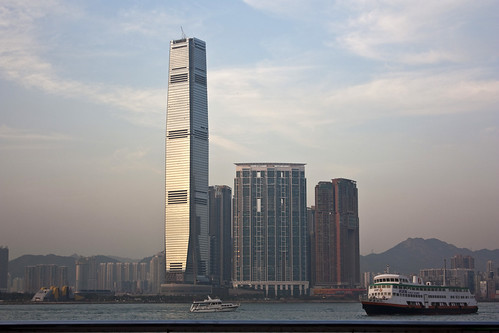
Dubai. Photo by Zeyad T. Al-Mudhaf
The Burj Khalifa defies the imagination. It stands nearly one kilometre above the streets of Dubai, spanning a total of 163 floors — 209 if you could the maintenance levels in the building’s spire. When it was completed in 2010, at a cost of more than US$1.5 billion, it was by far the world’s tallest building and almost certainly its most extravagant. That extravagance was made all the more apparent by the economic turmoil that shook the world just before the Burj was set to open. Dubai was on the verge of bankruptcy, saved only by a US$10 billion bailout from the ruler of nearby Abu Dhabi, for whom the Burj was ultimately named. With most floors standing vacant and maintenance costs as dizzyingly high as the building itself — it takes a full four months just to clean the windows — the Burj revived long-standing questions about the sustainability of super-tall skyscrapers.
Those questions are especially relevant in Asia, where seven of the world’s ten tallest buildings can be found. Another 30 buildings taller than 300 metres — generally considered the limit between an ordinary high-rise and a “super-tall” — are now under construction in South Korea, China, Taiwan, Vietnam, Thailand and India.
“It’s an ego thing,” says co-founder of Singapore’s WOHA Architects, Richard Hassell. “I think a lot of the developers themselves have a ‘mine’s bigger and better than yours’ mentality. I think cheap energy was bad for architecture because people could basically make any kind of building comfortable, and that freed up the building to be anything they wanted it to be, so architecture’s become a bit lost in gratuitous form-making. The Dubai ‘look-at-me’ architecture. It’s a bit of a dead end.”

International Commerce Centre, Hong Kong
But extravagantly tall buildings do have their advantages. “There’s good vanity and useless vanity,” says Paul Katz, director of Kohn Pedersen Fox, which has designed many of the world’s tallest skyscrapers, including the Shanghai World Financial Center, the recently-completed International Commerce Centre in Hong Kong and the Ping An International Finance Center in Shenzhen, which will be the world’s second-tallest building when it is completed in 2014. Well-designed skyscrapers can be extremely efficient, says Katz, because the density they create reduces the energy needed to house and transport large masses of people. “I think the real problem in the world right now is sprawl, not density,” he says. “We need to look at how to have tall buildings without creating too much waste.”
A key to doing that is to ensure that super-tall skyscrapers anchor a cluster of other high-rises, all of them linked to a well-developed public transportation network. Adaptability is another essential ingredient. “Buildings that are too idiosyncratic make it hard to adapt to other uses,” says Katz. “Many of the tall buildings in New York have seen their uses change many times over the past hundred years,” such as the Woolworths Building, once the world’s tallest, which was a corporate headquarters when it opened in 1910 and is now home to a mix of educational institutions, offices and apartments.
Other architects are exploring even more innovative ways of making skyscrapers sustainable. MAD Office founder Ma Yansong, who recently designed the 358-metre Sinosteel International Plaza in Tianjin, is now working on Urban Forest, a 385-metre mixed-use tower that incorporates gardens on every floor, as a way to humanize a form that has traditionally been driven by technology.
“Whoever can build taller has mastered the technology and has the most money,” he says. “We can already go to the moon, so what’s special about a high-rise? Eventually it becomes a competition with no meaning. There’s nothing there, only the height.”

Urban Forest, Chongqing
For all the criticism levied at buildings like the Burj Khalifa, however, there is still a symbolic power attached to structures of great height. When the World Trade Center in New York was destroyed by terrorists on September 11th, 2001, a decision was eventually made to replace it with an even taller building. The new One World Trade Center will open next year at a height of 541 metres — or 1,776 feet, a representation of the year the United States declared its independence as a nation.
Shortly after September 11th, Paul Katz was asked by a Newsweek reporter whether the attacks marked the end of the skyscraper era. “I told them that in ten years we’d be seeing taller buildings than ever before,” he recalls. “I said that more out of hubris than certainty, but in hindsight I was right.”
For all the criticism levied at buildings like the Burj Khalifa, however, there is still a symbolic power attached to structures of great height. When the World Trade Center in New York was destroyed by terrorists on September 11th, 2001, a decision was eventually made to replace it with an even taller building. The new One World Trade Center will open next year at a height of 541 metres — or 1,776 feet, a representation of the year the United States declared its independence as a nation.
Shortly after September 11th, Paul Katz was asked by a Newsweek reporter whether the attacks marked the end of the skyscraper era. “I told them that in ten years we’d be seeing taller buildings than ever before,” he recalls. “I said that more out of hubris than certainty, but in hindsight I was right.”
No comments:
Post a Comment